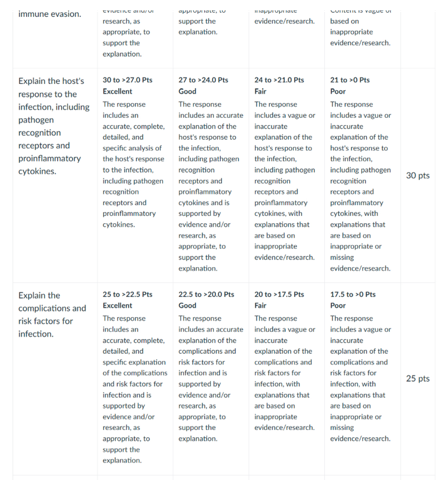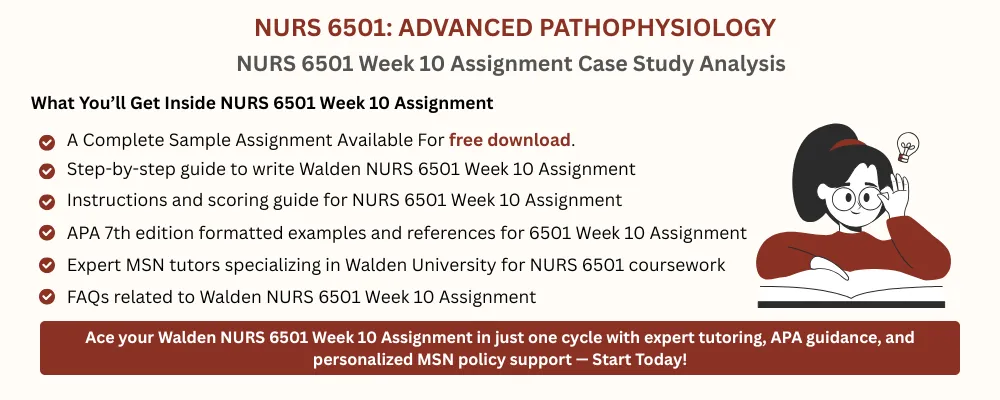NURS 6501 Week 10 Assignment FREE DOWNLOAD
NURS 6501 Week 10 Assignment
Case Study Analysis
Student Name
Walden University
NURS 6501: Advanced Pathophysiology
Professor Name
Date
Case Study Analysis
Chlamydia trachomatis is a gram-negative obligate intracellular bacterium responsible for one of the most prevalent sexually transmitted diseases in the world. Its pathophysiologic process is a distinctive biphasic developmental cycle comprised of two different forms: the elementary body (EB) and reticulate body (RB). EB is a form responsible for infection when it exists outside of host cells and enters and attaches to epithelial cells through a process of endocytosis. After entry into a host cell, EB converts to a metabolically active and replicating form known as RB, contained in a special membrane-bound compartment known as an inclusion (Rucks, 2023). After a series of binary division cycles, RB is transformed back to EB, and these exit to infect neighboring cells. This intracellular biology permits Chlamydia to escape immune detection by its host. It can also suppress apoptosis of host cells and control immune signaling to foster persistence and cause long-term infection and exacerbate associated complications such as scarring and infertility.
Host’s Response to the Infection
Pattern recognition receptors (PRRs) on immunological and epithelial cells recognize the pathogen, which triggers the host’s immune response to a chlamydia infection. Pathogen-associated molecular patterns (PAMPs) on the surface of Chlamydia are recognized by NOD-like receptors and Toll-like receptors (TLR2 and TLR4) (Cestari et al., 2021). Tumor necrosis factor-alpha (TNF-α), interleukin-1 (IL-1), interleukin-6 (IL-6), and interleukin-8 (IL-8) are among the proinflammatory cytokines released by the recognition. Neutrophils are drawn to infected locations by IL-8, which results in inflammation. This immune response harms the epithelium lining while also aiding in the management of infections. Chronic or repeated infection results in fibrosis and scarring of tissues, especially in the genital tract. Although the immune response is initiated by the immune system, Chlamydia is able to suppress apoptosis and evade detection to cause persistent infection with little or even without detection.
Risk Factors for STDs
A number of factors heighten an individual’s risk to sexually transmitted diseases, such as chlamydia. The most important factor is age when people younger than age 25 are at greater risk because of biological susceptibility and behavioral factors. Cervical ectopy is a prevalent condition in younger females, such as in this patient at age 21, in which columnar epithelial cells are more exposed and susceptible to infection (López-Filloy et al., 2022). Risk significantly increases through unprotected sex, a new sexual partner, or numerous sexual contacts. A history of past STIs also exposes a patient to future infection because it can be a measure of ongoing high-risk behaviors. Easy availability of healthcare services and routine screening are also a factor to prevent undiagnosed and untreated infection and thereby reduce transmission (Fairley et al., 2022). Other factors include low economic conditions, drug abuse, and poor sexual health education, such as poor decision-making and reduced protective measures such as use of a condom.
Possible Complications of Chlamydia
If it is not treated, chlamydia infection can bring about severe consequences, particularly in women. The most important complication is pelvic inflammatory disease (PID), a disease in which infection migrates upward through the cervical tissue to result in infection of the uterus, fallopian tubes, and ovaries. PID can lead to chronic pelvic pain, tubal infertility, and risk of ectopic pregnancy in response to scarring and adhesions. Chlamydia infection in pregnant women has the potential to be transmitted to the infant at delivery to cause neonatal pneumonia or conjunctivitis (Adachi et al., 2021). Men can experience epididymitis with accompanying ache and potential infertility in a small percentage of cases. Both men and women are also susceptible to developing reactive arthritis (Reiter’s syndrome), a triad of arthritis, urethritis, and conjunctivitis (Jubber & Moorthy, 2021). Chlamydia-induced inflammation also results in mucosal vulnerability to infection with HIV, enhancing susceptibility to and transmission of HIV. Early diagnosis and therapy are necessary to avoid these consequences and to break infection recurrences.
Struggling with your NURS 6501 Week 8 Assignment Case Study Analysis? Get professional help now and boost your grade!
Instructions To Write NURS 6501 Week 10 Assignment
Need instructions for this assessment? Contact us now and get expert guidance right away!
Instructions File For 6501 Week 10 Assignment
CASE STUDY ANALYSIS
An understanding of the factors surrounding women’s and men’s health can be critically important to disease diagnosis and treatment in these areas. This importance is magnified by the fact that some diseases and disorders manifest differently based on the sex of the patient.
Effective disease analysis often requires an understanding that goes beyond the human systems involved. The impact of patient characteristics, as well as racial and ethnic variables, can also have an important impact.
An understanding of the symptoms of alterations in systems based on these characteristics is a critical step in diagnosis and treatment of many diseases. For APRNs, this understanding can also help educate patients and guide them through their treatment plans.
In this Assignment, you examine a case study and analyze the symptoms presented. You identify the elements that may be factors in the diagnosis, and you explain the implications to patient health.
RESOURCES
Be sure to review the Learning Resources before completing this activity.
Click the weekly resources link to access the resources.
WEEKLY RESOURCES
To prepare:
By Day 1 of this week, you will be assigned to a specific case study scenario for this Case Study Assignment. Please see the “Announcements” section of the classroom for your assignment from your instructor.
The Assignment (1- to 2-page case study analysis)
Develop a 1- to 2-page case study analysis by answering the questions provided following the case scenario.
BY DAY 7 OF WEEK 10
Submit your Case Study Analysis Assignment by Day 7 of Week 10.
Reminder: The College of Nursing requires that all papers submitted include a title page, introduction, summary, and references. The sample paper provided at the Walden Writing Center provides an example of those required elements (available at https://academicguides.waldenu.edu/writingcenter/templates).
SUBMISSION INFORMATION
Before submitting your final assignment, you can check your draft for authenticity. To check your draft, access the Turnitin Drafts from the Start Here area.
To submit your completed assignment, save your Assignment as WK10Assgn2_LastName_Firstinitial
Then, click on Start Assignment near the top of the page.
Next, click on Upload File and select Submit Assignment for review.
NURS 6501 Week 10 Assignment Rubrics



References For NURS 6501 Week 10 Assignment
Adachi, K. N., Nielsen-Saines, K., & Klausner, J. D. (2021). Chlamydia trachomatis screening and treatment in pregnancy to reduce adverse pregnancy and neonatal outcomes: A review. Frontiers in Public Health, 9. https://doi.org/10.3389/fpubh.2021.531073
Cestari, B., Mansur, F., & Sérgio Podgaec. (2021). A systematic review of toll-like receptors in endometriosis. Archives of Gynecology and Obstetrics, 304(2), 309–316. https://doi.org/10.1007/s00404-021-06075-x
Fairley, C. K., Chow, E. P. F., Simms, I., Hocking, J. S., & Ong, J. J. (2022). Accessible health care is critical to the effective control of sexually transmitted infections. Sexual Health, 19(4). https://doi.org/10.1071/sh22042
Jubber, A., & Moorthy, A. (2021). Reactive arthritis: A clinical review. Journal of the Royal College of Physicians of Edinburgh, 51(3), 288–297. https://doi.org/10.4997/jrcpe.2021.319
López-Filloy, M., Cortez, F. J., Tarik Gheit, Cruz, O., Cruz-Talonia, F., Monserrat Chávez-Torres, Arteaga-Gómez, C., Mancilla-Herrera, I., Juan José Montesinos, Víctor Adrián Cortés-Morales, Cecilia Pérez-Soba Aguilar, Tommasino, M., Pinto-Cardoso, S., & Rocha-Zavaleta, L. (2022). Altered vaginal microbiota composition correlates with human papillomavirus and mucosal immune responses in women with symptomatic cervical ectopy. Frontiers in Cellular and Infection Microbiology, 12. https://doi.org/10.3389/fcimb.2022.884272
Rucks, E. A. (2023). Type III secretion in chlamydia. Microbiology and Molecular Biology Reviews: MMBR, 87(3), e0003423. https://doi.org/10.1128/mmbr.00034-23
Best Professors To Choose From For NURS 6501 Class
- Dr. Mary Smith
- Dr. Tara Harris
- Dr. Mahaman Moussa
- Dr. Annaliza (Anna Liza) Villena
- Dr. Morgan Skinner
(FAQs) related to NURS 6501 Week 10 Assignment
Question 1: Where can I download a free sample for NURS 6501 Week 10 Assignment?
Answer 1: Download a free sample from Tutors Academy.
Question 2: Where can I find the rubrics and instruction file for NURS 6501 Week 10 Assignment?
Answer 2: Get the rubric and instruction file from the Tutors Academy website.
Do you need a tutor to help with this paper for you with in 24 hours.
- 0% Plagiarised
- 0% AI
- Distinguish grades guarantee
- 24 hour delivery

